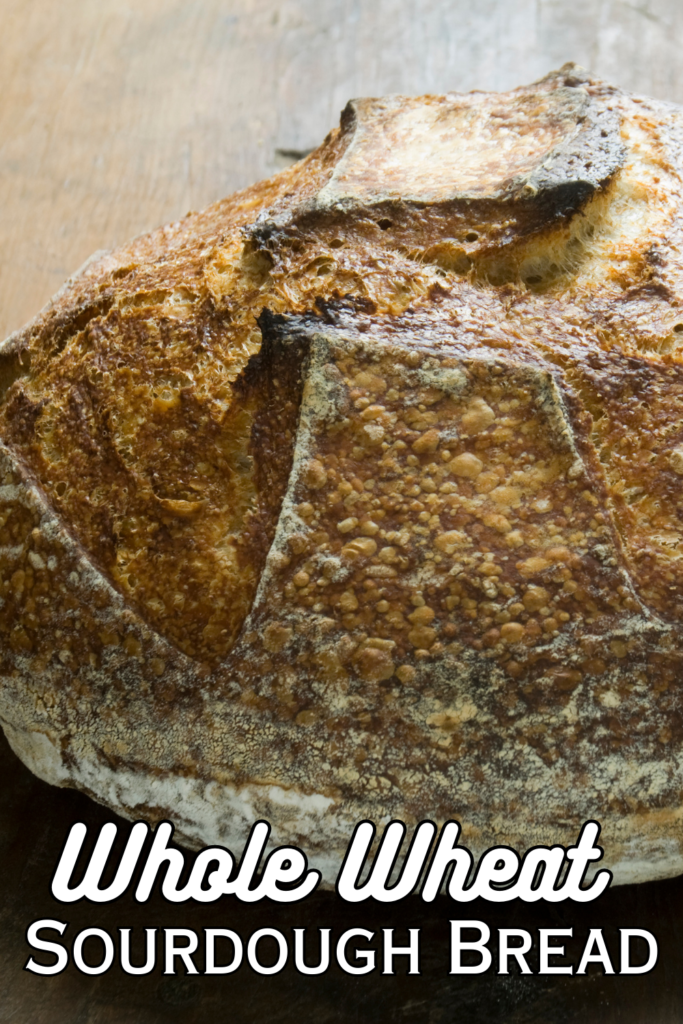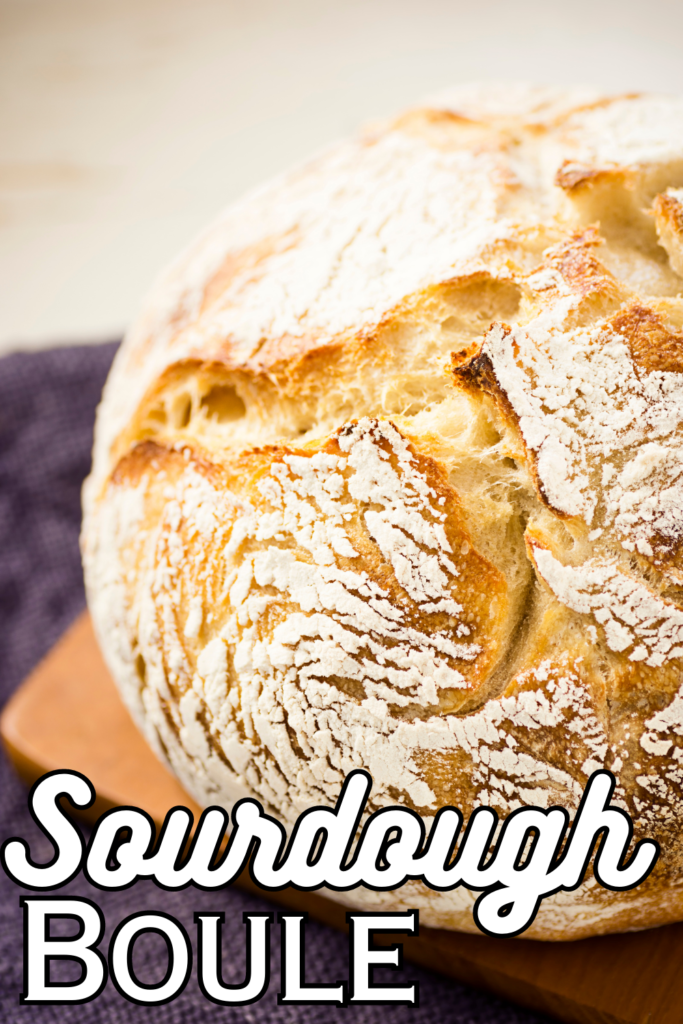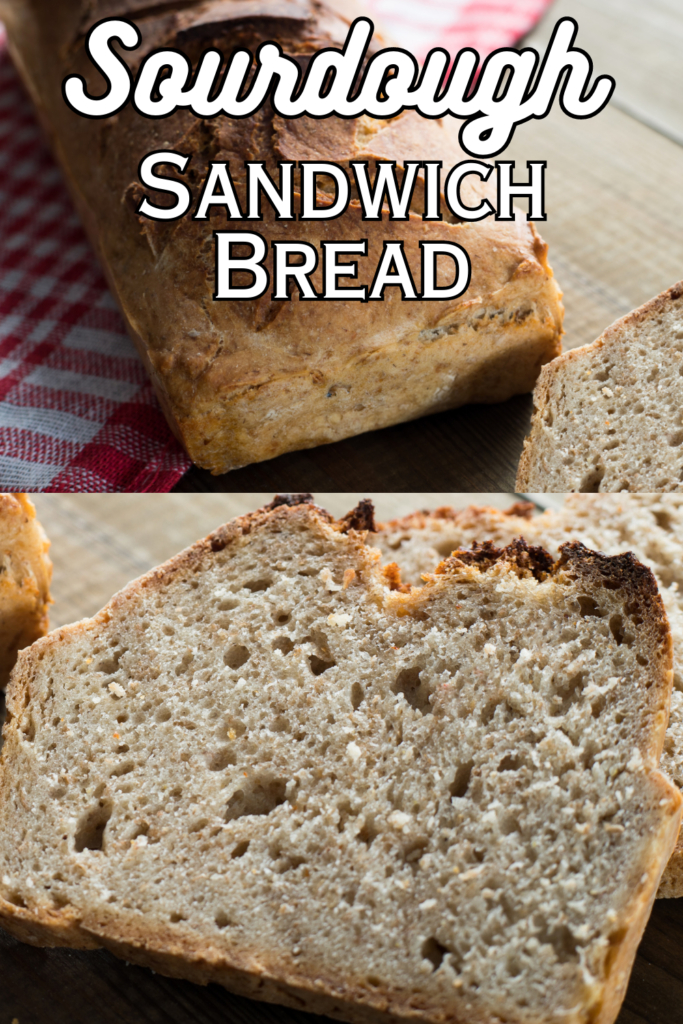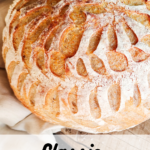Sourdough breads are made from naturally fermented dough. There are many different types of sourdough bread, each with its own unique flavor and texture. Here are some of the most popular types:
- Classic sourdough breads or Sourdough Boule: This is the most basic and traditional type of sourdough bread. It has a tangy, slightly sour flavor and a chewy texture.
- Whole wheat sourdough breads: Made with whole wheat flour, this bread has a nutty flavor and a denser texture than classic sourdough.
- Rye sourdough breads: Made with rye flour, this bread has a distinct flavor and dense texture. It’s often enjoyed with savory toppings like smoked salmon or pickled herring.
- French sourdough breads: This type of sourdough is characterized by its light and airy texture, crispy crust, and mild flavor.
- Sourdough baguette: A classic French bread, the baguette can also be made with sourdough for added flavor and a chewy texture.
- San Francisco sourdough: This type of sourdough is characterized by its sour flavor and chewy texture. It’s often used for sandwiches and toast.
The type of sourdough bread you choose will depend on your personal taste preferences and the specific recipe you are using.

Classic Sourdough Breads Recipe
A simple recipe for a long-fermented sourdough bread:
Ingredients:
- 400g bread flour
- 100g whole wheat flour
- 360g water (at room temperature)
- 100g active sourdough starter
- 10g salt
- 400g bread flour = 3 cups bread flour
- 100g whole wheat flour = 3/4 cup whole wheat flour
- 360g water = 1 1/2 cups water
- 100g active sourdough starter = 1/2 cup active sourdough starter
- 10g salt = 1 3/4 teaspoons salt
Please note that these conversions are approximate, as the weight of ingredients can vary depending on a variety of factors such as humidity and how the ingredients are measured. For best results, I recommend using a kitchen scale to measure ingredients by weight.
Instructions:
- In a large mixing bowl, combine the bread flour, whole wheat flour, and water. Mix until the ingredients are fully incorporated.
- Add the active sourdough starter to the mixing bowl and mix until the dough comes together. Cover the bowl with a kitchen towel and let it rest for 30 minutes.
- After 30 minutes, sprinkle the salt over the dough and use your hands to fold the dough over itself a few times to distribute the salt evenly. Cover the bowl again and let it rest for 30 minutes.
- Repeat the folding and resting process three more times, for a total of four times over the course of two hours.
- After the final fold, cover the bowl with a lid or plastic wrap and let it rest at room temperature, or in the fridge, for 12-16 hours. This will allow the dough to ferment and develop flavor.
- The next morning, preheat your oven to 450°F (230°C). Place a cast iron Dutch oven or baking stone in the oven to preheat as well.
- Meanwhile, gently turn the dough out onto a lightly floured surface and shape it into a round loaf. Let it rest on the floured surface for 30 minutes.
- When the oven is preheated, carefully transfer the dough to the preheated Dutch oven or baking stone. Use a sharp knife or razor blade to make a few shallow slashes in the top of the dough.
- Bake the bread for 30-35 minutes, or until the crust is golden brown and the internal temperature of the bread reaches 200°F (93°C).
- Remove the bread from the oven and let it cool on a wire rack for at least 30 minutes before slicing and serving.
You can get a simple sourdough bread recipe for beginners where I walk you through every step here!

Whole Wheat (Long Fermented) Sourdough Breads
a simple long-fermented whole wheat sourdough bread:
Ingredients:
- 400g whole wheat flour
- 360g water (at room temperature)
- 100g active sourdough starter
- 10g salt
- 400g bread flour = 3 cups bread flour
- 360g water = 1 1/2 cups water
- 100g active sourdough starter = 1/2 cup active sourdough starter
- 10g salt = 1 3/4 teaspoons salt
Please note that these conversions are approximate, as the weight of ingredients can vary depending on a variety of factors such as humidity and how the ingredients are measured. For best results, I recommend using a kitchen scale to measure ingredients by weight.
Instructions:
- In a large mixing bowl, combine the whole wheat flour and water. Mix until the ingredients are fully incorporated.
- Add the active sourdough starter to the mixing bowl and mix until the dough comes together. Cover the bowl with a kitchen towel and let it rest for 30 minutes.
- After 30 minutes, sprinkle the salt over the dough and use your hands to fold the dough over itself a few times to distribute the salt evenly. Cover the bowl again and let it rest for 30 minutes.
- Repeat the folding and resting process three more times, for a total of four times over the course of two hours.
- After the final fold, cover the bowl with a lid or plastic wrap and let it rest at room temperature, or in the fridge, for 12-16 hours. This will allow the dough to ferment and develop flavor.
- The next morning, preheat your oven to 450°F (230°C). Place a cast iron Dutch oven or baking stone in the oven to preheat as well.
- Meanwhile, gently turn the dough out onto a lightly floured surface and shape it into a round loaf. Let it rest on the floured surface for 30 minutes.
- When the oven is preheated, carefully transfer the dough to the preheated Dutch oven or baking stone. Use a sharp knife or razor blade to make a few shallow slashes in the top of the dough.
- Bake the bread for 30-35 minutes, or until the crust is golden brown and the internal temperature of the bread reaches 200°F (93°C).
- Remove the bread from the oven and let it cool on a wire rack for at least 30 minutes before slicing and serving.
Enjoy your delicious long-fermented whole wheat sourdough bread.

Sourdough Rye Breads Recipe
a simple recipe for a long-fermented rye sourdough bread:
Ingredients:
- 300g rye flour
- 200g bread flour
- 360g water (at room temperature)
- 100g active sourdough starter
- 10g salt
- 300g rye flour = 2 cups rye flour
- 200g bread flour = 1 1/2 cups bread flour
- 360g water = 1 1/2 cups water
- 100g active sourdough starter = 1/2 cup active sourdough starter
- 10g salt = 1 3/4 teaspoons salt
Instructions:
- In a large mixing bowl, combine the rye flour, bread flour, and water. Mix until the ingredients are fully incorporated.
- Add the active sourdough starter to the mixing bowl and mix until the dough comes together. Cover the bowl with a kitchen towel and let it rest for 30 minutes.
- After 30 minutes, sprinkle the salt over the dough and use your hands to fold the dough over itself a few times to distribute the salt evenly. Cover the bowl again and let it rest for 30 minutes.
- Repeat the folding and resting process three more times, for a total of four times over the course of two hours.
- After the final fold, cover the bowl with a lid or plastic wrap and let it rest at room temperature for 12-16 hours. This will allow the dough to ferment and develop flavor.
- The next morning, preheat your oven to 450°F (230°C). Place a cast iron Dutch oven or baking stone in the oven to preheat as well.
- Meanwhile, gently turn the dough out onto a lightly floured surface and shape it into a round loaf. Let it rest on the floured surface for 30 minutes.
- When the oven is preheated, carefully transfer the dough to the preheated Dutch oven or baking stone. Use a sharp knife or razor blade to make a few shallow slashes in the top of the dough.
- Bake the bread for 30-35 minutes, or until the crust is golden brown and the internal temperature of the bread reaches 200°F (93°C).
- Remove the bread from the oven and let it cool on a wire rack for at least 30 minutes before slicing and serving.

Simple French Sourdough Breads
Ingredients:
- 500g bread flour
- 350g water (at room temperature)
- 100g active sourdough starter
- 10g salt
Instructions:
- In a large mixing bowl, combine the bread flour and water. Mix until the ingredients are fully incorporated.
- Add the active sourdough starter to the mixing bowl and mix until the dough comes together. Cover the bowl with a kitchen towel and let it rest for 30 minutes.
- After 30 minutes, sprinkle the salt over the dough and use your hands to fold the dough over itself a few times to distribute the salt evenly. Cover the bowl again and let it rest for 30 minutes.
- Repeat the folding and resting process three more times, for a total of four times over the course of two hours.
- After the final fold, cover the bowl with a lid or plastic wrap and let it rest at room temperature for 8-12 hours. This will allow the dough to ferment and develop flavor.
- The next morning, preheat your oven to 450°F (230°C). Place a cast iron Dutch oven or baking stone in the oven to preheat as well.
- Meanwhile, gently turn the dough out onto a lightly floured surface and shape it into a round loaf. Let it rest on the floured surface for 30 minutes.
- When the oven is preheated, carefully transfer the dough to the preheated Dutch oven or baking stone. Use a sharp knife or razor blade to make a few shallow slashes in the top of the dough.
- Bake the bread for 30-35 minutes, or until the crust is golden brown and the internal temperature of the bread reaches 200°F (93°C).
- Remove the bread from the oven and let it cool on a wire rack for at least 30 minutes before slicing and serving.

Sourdough Breads VS Sourdough Boule
A sourdough boule and a nice round loaf of sourdough bread are essentially the same thing. “Boule” is a French word for “ball,” and in the context of bread, it refers to a round or ball-shaped loaf.
So, when you see the term “sourdough boule,” it typically just indicates a round-shaped sourdough bread. The choice of the term may simply be a stylistic preference or a nod to the traditional French terminology used in artisan bread baking. In essence, whether referred to as a boule or a round loaf, both describe a delicious, round-shaped sourdough bread.
The main difference between classic sourdough bread and sourdough boule is the shape and size of the loaf.
Classic sourdough bread can refer to any type of bread made with a sourdough starter, including boules, baguettes, batards, and more. The defining characteristic of sourdough bread is the use of a natural sourdough starter instead of commercial yeast to leaven the dough.
A sourdough boule, on the other hand, is a specific type of sourdough bread that is typically round and has a crusty exterior and soft interior. The word “boule” is French for ball, which describes the round shape of the loaf. Sourdough boules are often baked in a Dutch oven or similar vessel to help create a crisp crust and moist crumb.

Sourdough Sandwich Breads Recipe
Ingredients:
- 500g bread flour
- 350g water (at room temperature)
- 100g active sourdough starter
- 10g salt
- 2 tablespoons sugar (optional)
- 2 tablespoons unsalted butter, softened (optional)
Measurements in cups
- 4 cups bread flour
- 1 1/2 cups water (at room temperature)
- 1/2 cup active sourdough starter
- 2 teaspoons salt
- 2 tablespoons sugar (optional)
- 2 tablespoons unsalted butter, softened (optional)
Instructions:
- In a large mixing bowl, combine the bread flour, water, active sourdough starter, sugar, and unsalted butter (if using). Mix until the ingredients are fully incorporated.
- Add the salt to the mixing bowl and mix until the dough comes together. Cover the bowl with a kitchen towel and let it rest for 30 minutes.
- After 30 minutes, use your hands to knead the dough for a few minutes until it becomes smooth and elastic. Cover the bowl again and let it rest for 30 minutes.
- Repeat the kneading and resting process two more times, for a total of three times over the course of 1-2 hours.
- After the final kneading, shape the dough into a loaf and place it in a greased bread pan. Cover the bread pan with a kitchen towel and let the dough rise for 4-6 hours, until it has doubled in size.
- Preheat your oven to 375°F (190°C). Place the bread pan in the oven and bake for 40-50 minutes, or until the bread is golden brown and the internal temperature reaches 190°F (87°C).
- Remove the bread from the oven and let it cool in the pan for 10 minutes before turning it out onto a wire rack to cool completely.
- Once the bread is completely cool, slice it into pieces and enjoy!

About Juliea
Juliea Huffaker is the creator of Farmhouse Harvest, and dedicated to teaching from-scratch cooking, sourdough baking, gardening, and food preservation. With over 25 years of hands-on experience she has preserved hundreds of jars of produce, mastered the art of meats and sourdough baking, and nurtured a thriving organic garden. Her recipes and articles have been featured across the web. And she’s passionate about inspiring others to embrace a simpler, self-sufficient life style.








